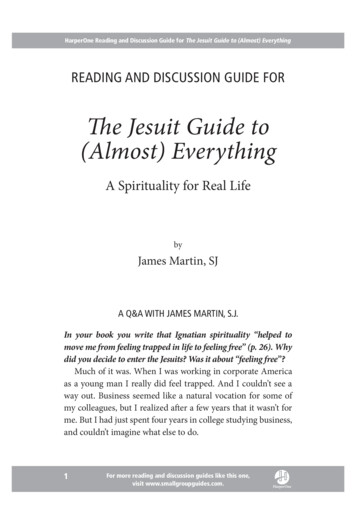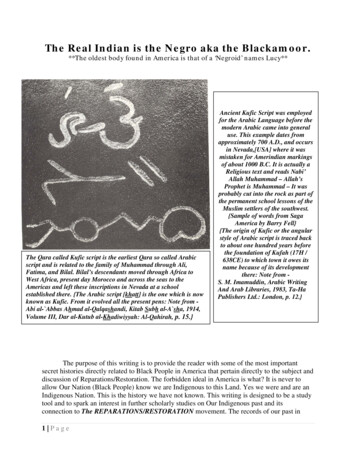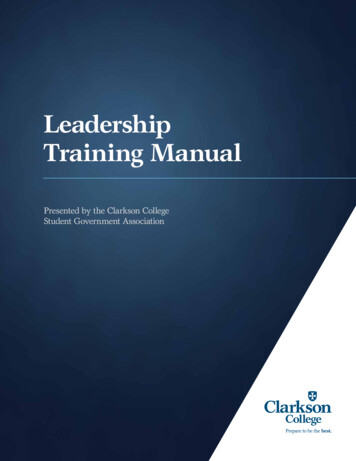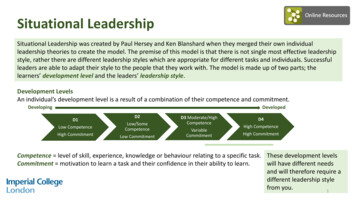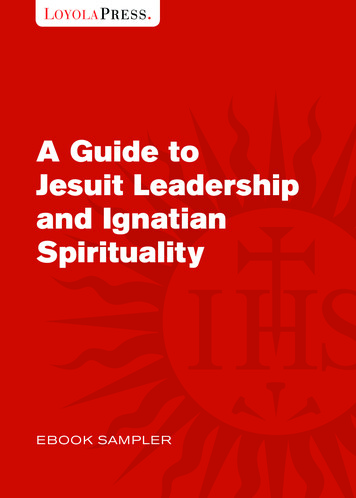
Transcription
A Guide toJesuit Leadershipand IgnatianSpiritualityEBOOK SAM PLER
A Guide to JesuitLeadership and IgnatianSpiritualityOur newly elected Pope Francis was educatedand formed by the Jesuit principles ofleadership and Ignatian spirituality. It is a richheritage that guides him in his relationshipwith God and with the world. The titles in thissampler offer some insight and perspective onthe key elements of the man just elected tolead the world’s Catholics. Fromunderstanding the foundational pillars ofJesuit leadership to learning how to practicethe simple yet powerful Examen prayer, eachbook offers a glimpse into the formativeprinciples of our new Pope Francis, and achance to enrich our lives as well.
Hereroicoic Leadership by Chris LowneyJust Call MMee LópeLópezz by Margaret SilfThe IIgnatiangnatian AAdvdventurenturee by Kevin O’Brien, SJA SSimple,imple, Life-Changing Prayrayerer by Jim ManneyAFFriendshipriendship Like NNoo OOtherther by William A. Barry, SJThe IIgnatiangnatian WWororkoutkout by Tim MuldoonWhat IIss IIgnatiangnatian SSpirituality?pirituality? by David L. Fleming, SJ
Explore Ignatian Spiritualityonline . . .www.IgnatianSpirituality.comVisit us online to Join our E-Magis newsletter Pray the Daily Examen Make an online retreat with the Ignatian PrayerAdventure Join the conversation on the dotMagis blog Share your experiences at Facebook.com/IgnatianSpirituality
Heroic LeadershipBest PPracticesractices frfromom a 450-Y450-Year-Oear-Oldld Company ThatChanged the WWorldorldChris LowneyChristian leaders, by definition, are called to follow a different set of leadershipprinciples than other leadersfollow. But what are they, andhow do Christian leaders follow them? In HeroicLeadership Jesuit-seminarianturned-investment-bankerChris Lowney examines organizational principles of effective leadership derived fromthe history and teachings ofthe Jesuits and applies them to modern corporate culture. Basedon the four core values of self-awareness, ingenuity, love, andheroism, this book identifies practices that sixteenth-centurypriests developed to foster dynamic, effective leaders and achievelongevity.
Chris Lowney, a former Jesuit, named amanaging director J. P. Morgan & Co.while still in his thirties and held seniorpositions in New York, Tokyo, Singapore, and London before leaving thefirm in 2001. He is the author of thebest-selling Heroic Leadership andHeroic Living: Discover Your Purposeand Change the World Lowney lives in New York. Visit his Website at www.chrislowney.com.Other Books bbyy Chris LoLowneywneyHeroic Living: Discover Your Purpose and Change theWorld
The JesuitsAn AAccidentalccidental Company with a PPurposefulurposeful VVisionisionJesuits enjoy enviable brand-name recognition. But while everyone knows why Coca-Cola is famous, the Jesuit brand oftensummons only a vague jumble of disconnected facts, anecdotes,and images: a handy epithet to hurl at a cunning adversaryin a negotiation (“Jesuitical”), the image of a priest packedinto a police van at a Vietnam War protest, or of another oneretiring from Congress at the behest of a disapproving pope,or of still others slaughtered by armed forces in El Salvador.Jesuit also brings to mind quality educational institutions, withan alumni roster including Bill Clinton, François Mitterrand,Antonin Scalia, and Fidel Castro; and quality college basketballteams, with a deep bench of perennial NCAA championshipcontenders, including Georgetown, Gonzaga, Boston College,Marquette, and the University of Detroit Mercy.The ten Jesuit founders were an unlikely group, a vastly morediverse team than headed most sixteenth-century companiesand organizations. Twenty-four years separated the youngestfrom the oldest of a motley group of Spaniards, French, and aPortuguese. Their family and socioeconomic backgrounds created an equally wide gulf. Pierre Favre was the son of poorFrench subsistence farmers. Francis Xavier was a Basque noblefrom Navarre, raised in his family’s castle and well placed toinherit a hefty benefice later in life. Like Xavier, the Castilian
Diego Laínez was also wealthy. But unlike Xavier or any of theothers, Laínez also happened to be the great-grandson of a Jewand therefore a “New Christian” in the rabidly anti-Semitic codeof Inquisition-era Spain. New Christians were not even permitted to join major religious orders, so it was ironic that Laínezhelped found one, and more ironic still that he succeeded Loyola to become the Jesuits’ second general.The core group slowly coalesced while studying for advanceddegrees at the University of Paris, then the world’s most prestigious university system. Though most of them distinguishedthemselves even in that selective academic circle, their intellectual gifts varied no less widely than their backgrounds. One ofthem recalled Diego Laínez as being “endowed with a singular,almost divine, intellect, well nigh miraculously informed in thesubtleties of various branches of learning.” On the other hand,Laínez himself couldn’t help but note Ignatius Loyola’s “limitedendowments of eloquence and learning.”
Still, the one with the “limitedendowments” of eloquence and learningbecame the group’s focal point. On theface of it, this handful of Europe’s toptalent had chosen to rally around a mostunlikely character utterly lacking inconventional leadership credentials. Atthe age of thirty-eight, well into the twilight of an average sixteenth-centurylifetime, Loyola’s track record hardlysuggested leadership potential—twofailed careers, two arrests, multiple runins with the Spanish Inquisition and other authorities, and nomoney. He had no notable accomplishments, no clear prospects,no followers, and no plan.Would you sign up with this man?At the age ofthirty-eight, well intothe twilight of anaveragesixteenth-centurylifetime, Loyola’strack record hardlysuggested leadershippotential—two failedcareers, two arrests,multiple run-ins withthe SpanishInquisition and otherauthorities, andno money.A Leader Twice BornHarvard Business School professor emeritus Abraham Zaleznikonce observed that “leaders are ‘twice born’ individuals whoendure major events that lead to a sense of separateness, or perhaps estrangement, from their environments. As a result, theyturn inward in order to reemerge with a created rather thanan inherited sense of identity.” Ignatius Loyola may have had askimpy resumé, but he certainly qualified as twice born. Birthnumber one was in Azpeitia, a tiny Basque village not far from
the French border in a remote area of northern Spain. The Loyolas were minor nobles, and while nobility hardly entailed a lifeof luxury in isolated Azpeitia, it did bring political connectionsthat provided Loyola’s ticket out of the hinterland. The teenageLoyola served as a page to the chief treasurer of the royal court.It was his apprenticeship for a military and courtly career; littletime was wasted on less critical skills like reading and writing,and plenty of time was devoted to swordsmanship and the codeof chivalry that so animated Cervantes’s Don Quixote.Loyola’s autobiography and later biographies offer only themost superficial glimpse of his early years, probably with goodreason. Hagiographers tend to airbrush away the more embarrassing details of a saint’s portrait, and some of Loyola’s biographers were no exception. Loyola had his flaws. The Jesuit JuanPolanco, who served as Loyola’s executive assistant, had occasion to hear the stories that slipped out at unguarded moments,and Polanco paints enough of a picture of “preconversion” Loyola for readers to imagine the rest: “Although much attachedto the faith, [Loyola] did not live in accordance with his belief,and he did not keep himself from sin. He was especially out oforder in regard to gambling, matters pertaining to women, andduelling.” He was arrested at least once for misdemeanors thatthe local magistrate avoided detailing in deference to the Loyola family but nonetheless called “most outrageous.” Anotherearly acquaintance recalled the testosterone-charged Loyola in
action: “[Loyola] drew his sword and chased them down thestreet. If someone had not restrained him, either he would havekilled one of them, or they would have killed him.” What graveoffense had prompted this unrestrained rage? Two passersby hadbumped into him in a narrow passageway.His first career, that of military officer, didn’t last very long.It ended with the battle that started it. Loyola and his garrisonhad the misfortune to be guarding the Spanish citadel at Pamplona when a far superior French army came calling. The heroicif misguided Basque rallied his compatriots for a certainly futiledefensive stand. It only delayed the inevitable, at the cost of hiscareer, his self-image, and very nearly his life, thanks to a Frenchcannonball that shattered his right leg.A dashing rake—as Loyola fancied himself—doesn’t dash asconvincingly with one leg hobbled by a battle injury. Nor dothe tight-fitting leggings favored at medieval courts make forvery flattering attire when a clumsily set bone leaves an ugly,pronounced protrusion below the knee. Still, the stubborn Loyola refused to surrender his military and courtly aspirationsimmediately, instead subjecting himself to the sixteenth-centuryequivalent of reconstructive cosmetic surgery. One imagines alargely self-taught “surgeon” gamely hacking away at the offending tibia with the sharpest available local excuse for a saw, andit’s safe to assume that there was no anesthesiologist on hand.It’s hard to decide what’s more remarkable: that Loyola survived
his battle injury or that he survived the subsequent surgery torepair the damage. In any event, he survived both. And whilethe surgery resulted in some improvement, it left him with aslight limp—and without a military career.The Jesuits’ pioneering leader This posthumous portrait ofIgnatius Loyola was painted by the Renaissance master Jacopinodel Conte in 1556. It is displayed in the international headquarters of the Society of Jesus in Rome.Loyola’s story unfolds with unfortunate storybook predictability: the dissolute youth, the personal crisis, the intenseconversion experience. The familiar, often romanticized plotline whitewashes what must have been a much more complicated internal struggle to reconstruct some sense of self and purpose. As gruesome as it was, his leg surgery might have been theeasier part of this personal reconstruction. The surgery lasted
only a few hours. But what Zaleznik would call Loyola’s secondbirth dragged on for the better part of a decade. A profoundand permanent religious conversion during his convalescencegave him a spiritual destination, but translating that goal intomature, sensible engagement in the everyday world proved along, drawn-out, torturous process.At first taken with fantasies of imitating the heroic deprivations he read about in popularized legends of the saints, “hethought of going to Jerusalem barefoot, and of eating nothingbut plain vegetables and of practicing all [the saints’] other rigors.” Though his fantasies were particular enough to encompass footwear and diet for the trip, other details were apparentlyof less concern to him—like what he would actually do oncehe reached Jerusalem. His family were as appalled by theill-conceived plan as any other family would be and did whatthey could to talk him out of it, “His brother took to one roomand then another, and with much feeling begged him not tothrow himself away.”To no avail. And thus began career two. Loyola traveled morethan two thousand miles in an era when few Europeans everstrayed more than ten miles from their birthplaces. He beggedfor food and lodging, frequently sleeping in open fields or huddled in doorways. Once so vain as to submit to a life-threateningleg operation in a desperate attempt to restore his appearance,he now swung wildly to the opposite extreme, as he related
in his autobiography (always referring to himself in the thirdperson): “He decided to let [his hair] go its way according tonature without combing or cutting it or covering it with anything by night or day. For the same reason he let the nails growon toes and fingers because he had been fastidious in this too.”Though Loyola was far from the first European to undertakea pilgrimage to the Holy Land, he must have made for a particularly pitiful sight. Devastating outbreaks of bubonic plaguestill swept European cities periodically, leaving urban dwellerspermanently vigilant and acutely anxious. Some towns refusedentry entirely to vagrants such as Loyola who were unable toprovide “passports” verifying good health. It isn’t surprising thatLoyola recalled bumping into a man in Venice who took onelook at the pilgrim and “fled in horror . . . presumably becausehe saw him so very pale.”Against the odds, Loyola landed in Jerusalem in the fallof 1523 after an eighteen-month odyssey—and was promptlydeported after three weeks. Jerusalem was a dangerous place forthe few solo travelers who managed to find their way there,and the religious order overseeing pilgrim visitors was growingexasperated and impoverished from having to ransom all theEuropeans taken hostage. Thus, Loyola’s second career, that ofspending his life in Jerusalem imitating the heroics of the saints,evaporated as quickly, if not as violently, as his first.
The discouraged deportee backtracked from Jerusalem. Afternear shipwreck he reached Venice. Six more months and sixhundred miles later he was in Barcelona, where at age thirtythree a resilient Loyola launched his third career: studying basicLatin grammar with a class of preteen boys. He devoted onlyone sentence of his autobiography to explaining this suddenshift in direction to what many might call the first sensiblething he had done with his life: “He continually ponderedwithin himself what he ought to do; and eventually he wasrather inclined to study for some time so he would be ableto help souls.” He crawled forward, from grammar studies inBarcelona, through college studies in Alcalá and Salamanca, andfinally to Paris, where he made the acquaintance of those whowould become his Jesuit cofounders. The future “CEO” of theJesuit company had finally landed at what most would considerthe starting point of his life’s calling, yet he was nearly fortyyears old, in the twilight years of an average sixteenth-centurylifespan.The Personal Appeal of a Twice-Born ManHow did anyone, much less a cross section of Europe’s best talent, ever allow himself to fall in with this guy? Eccentric seemstoo mild a word to describe Loyola’s life before reaching Paris.Granted, his wasn’t the most straightforward way to build aresumé. Nor was his career progression the sort that impressessearch committees: no painstaking climb up the corporate lad-
der, no assiduously cultivated network of power brokers, nosuccession of ever more accountable management positions, notrack record of results as a rainmaker.But omitted from the above itinerary of Loyola’s seven-yearjourney from Pamplona to Paris was a life-altering detour intothe tiny Spanish town of Manresa. Intending to rest there a fewdays, he stayed a year. Words failed his later attempts to describewith precision what happened there. But he left no doubt aboutthe impact of the mystical experiences that overwhelmed him.One afternoon spent on the banks of the river Cardoner “lefthis understanding so very enlightened that he felt as if he wereanother man with another mind.” If he added together everything he had ever learned in his lifetime, he continued, “he doesnot think he had got as much as at that one time.”Mystical though this experience may have been, magic it wasnot. Though in one spiritual gulp he apparently learned moreabout himself and the world than he had absorbed throughout his whole previous life, the profound revelation didn’t bringinsight about more mundane matters, such as “What job wouldI be good at?” Well, conventional wisdom notwithstanding, lifeis like that: there are dimensions to self-understanding beyondmerely choosing a career path. Loyola left Manresa with noclearer career plan than what he had when he arrived and foundhimself back on the road, pursuing his vague, unrealistic plan tospend his life in Jerusalem.
But what he had gained proved farmore important and durable thandivine career counseling—and is farmore important to an understanding oflasting leadership. He walked away withdeep self-understanding, able to pinpoint his flaws with greater maturityand accuracy than ever before, yet at thesame time able to appreciate himself as auniquely dignified and gifted person ina world that seemed far more positivethan it did when he entered Manresa.Though his personal pilgrimage continued, his self-punishmentstopped. He determined, for example, that it was no great sin tocomb one’s hair. Well, minor accomplishments precede greatones. If he didn’t know what job to do, his greater sense of purpose and direction now served as a personal compass of sorts.Finally, he had developed a worldview. Or in less grandioseterms, he understood how he fit into the world and that it wasnot a hostile place.The self-awareness he had won was ultimately what drew others, even Europe’s finest, to him. Of course, they must have beenattracted in part by his natural leadership gifts, which even hiseccentric history could not totally obscure—the heroism he displayed as the soldier rallying the defense of compatriots at PamThough in onespiritual gulp heapparently learnedmore about himselfand the world thanhe had absorbedthroughout his wholeprevious life, theprofound revelationdidn’t bring insightabout more mundanematters, such as“What job would I begood at?”
plona; the commitment and toughness he possessed as a pilgrimundeterred from his goal of reaching Jerusalem; and the resilientadaptability manifest in his transformation from soldier to pilgrim to remedial grammar student to university scholar. ButLoyola’s core appeal was not his own leadership traits—it washis ability to identify and unlock others’ latent leadership potential. Each member of the founding team tells a similar story ofundertaking a systematic self-examination under Loyola’s personal guidance and emerging energized, focused, and able toarticulate life goals and personal weaknesses. Here was supercharged mentoring from a man who modeled this poorly understood and drastically underutilized life tool. Loyola not onlygrasped his own strengths and weaknesses but also was generous,dedicated, and straightforward enough to guide others throughtheir own self-assessment.Loyola’s second birth lasted years and saw him wandering apenniless beggar for thousands of miles. But he had discovered away to spare others the trauma and lost years of his second birthwhile delivering the fruits of self-awareness that were borne ofit. He had translated his own experiences into an accessibleprogram of meditations and practices he called the SpiritualExercises. The members of his multinational, socioeconomicallydiverse team had little in common with one another uponarriving in Paris beyond their ambitions for the highest-qualityeducation then attainable. Their unifying team bond became
the common experience of undertaking these self-revelatoryExercises.As their mutual friendship develEach member of theoped, they banded together in a loosefounding team tells asimilar story ofassociation to help souls. To help souls?undertaking aWhat did that mean? What were theirsystematicself-examinationoccupations? What were their products?under Loyola’sThey couldn’t have answered thosepersonal guidanceand emergingquestions with much precision, and itenergized, focused,showed in early endeavors. They firstand able to articulatelife goals andresurrected Loyola’s quixotic earlypersonalambition to work in the Holy Land,weaknesses.making their way to Italy to obtainpapal approval for the pilgrimage. Asoften happens with ambitious but poorly conceived strategies,neither they nor their plan went anywhere. No ships were sailingfor Jerusalem; rising political tensions put ships venturing intothe Mediterranean at unacceptably high risk of raids fromOttoman Turkish fleets. So, to their great disappointment—but, as it turned out, to their own and the world’s greatfortune—the ten were effectively stranded in Italy, occupyingthemselves by preaching on street corners, working in hospitals,and doing whatever else fit their own broad conception of helping souls. Not all of them were equally talented at street religion.Colleagues remembered Loyola in Italian town squares, gamely
preaching away in some nearly unintelligible pidgin of Spanish,Latin, and Italian, ridiculed by children who pelted the balding,limping Basque with apples.The Formation of a CompanyDeeply self-aware or not, the Jesuits had, by superficial appearances, failed. In fact, however, the only thing they really failedat was escaping notice. Their drive, creativity, and resilienceattracted attention to even these haphazard early efforts. As sooften happens, quality was proving to be its own best advertisement, and Loyola’s bungled attempts at street preaching werethe only exception to the team’s overall performance excellence.The pope and other church officials began to pick the group forscattered missions to preach or lecture. Soon two were destinedfor Parma, two for Siena, and one for Naples. “Talent will out,”as the saying goes, and the Catholic Church’s need for talenthad rarely been greater. Martin Luther and other reformers hadmade extraordinary gains in Europe in little more than a generation. For more than a millennium the church had enjoyednear unchallenged hegemony in European spiritual and moralaffairs, yet after a twenty-year onslaught by the reformers, theVatican could count on secure allegiance from only a handful of countries rimming the Mediterranean. The institutionalCatholic Church was an easy target: corrupt bureaucrats filledits hierarchy, and the rank and file was riddled with poorly educated, demoralized clerics. Against this backdrop, the energy,
integrity, and raw intellectual horsepower of the new arrivalsfrom Paris combined into rare and badly needed tonic.But like many of today’s rising-star start-ups, the friendsrapidly became victims of their own success and reputation.After a few years in Italy, it became obvious that Loyola’s littleteam was on the verge of disintegrating. Already pulled in different directions, the team had amassed a backlog of projectsthat would have occupied “four times their number.” And thecentripetal force was accelerating. Within a few years the sameten would be scattered not only across Italy but across Europeand beyond: Portugal, Ireland, Germany, Austria, Switzerland,and India.The prospect of inevitable dispersion spurred their first serious debates about their long-term joint future. Should theyincorporate as a new religious order and elect a superior general?Or should they continue with their looser association, acceptingthat their far-flung assignments could mean its eventual dissolution? They discussed the issue intermittently over the course ofa summer, work demands allowing. In the end they decided toincorporate. Why?Heroism and mutual affection. Hardly what drives mostcompanies today—big, lumbering, bureaucratic, unimaginative,competitive, anonymous modern companies. What holds mostcompanies together today? The critical mass, scale, capital,global reach, and broad capabilities to pulverize opponents, yes.
Limited liability? Of course. The chance to become rich bygoing public? Naturally. But heroism and mutual affection? Notusually.The team accepted that work opportunities would separatethem physically; indeed, they relished the chances to flex theirtalent and imagination in uncharted territory. Shunningwide-ranging, far-flung opportunities merely to remain in closecontact was out of the question. Still, they seemed convincedthat there was a way to preserve the spirit that unified them evenas diverse missions separated them physically. The question theyasked themselves makes clear that what they got out of theircompany is not quite what most of us get out of our companies:“Should we have a mutual understanding so that those who aresent from our midst will still be the object of our affectionateconcern as we will be of theirs?” After all, why else does anyoneform or join a company? Otherwise, why not go it alone?Still, the decision to incorporateThey seemedwasn’t straightforward. There wereconvinced that therewas a way todrawbacks to consider. Sixteenth-cenpreserve the spirittury religious orders were not highlythat unified themeven as diverseesteemed, and one cofounder arguedmissions separatedthat formal incorporation would onlythem physically.damage the team’s hard-won reputationfor integrity: “It seems this term ‘religious obedience’ has fallen into disfavor and has been discred-
ited among Christian people.” Moreover, they envisioned anorder that would have wide-open flexibility to pursue emergingopportunities, and they feared the pope might saddle them withan already existing religious rule that would hem them in and“not provide ample opportunity and scope” for carrying outtheir broad vision. They wanted to protect their ability to mobilize, adapt, and innovate.One argument convincingly trumped these negatives: “Obedience issues in an uninterrupted life of heroic deeds and heroicvirtues. For one who truly lives under obedience is fully disposedto execute instantly and unhesitatingly whatever is enjoinedhim, no matter to him whether it be very hard to do.”An uninterrupted life of heroic deeds and heroic virtues.Something else we don’t typically associate with most companies. But Loyola’s team did. Incorporation was the path to heroism and the best way to preserve mutual “affectionate concern.”They resolved to formalize their association and sought papalapproval to found a new religious order to be called the Compañía de Jesus.The Merger That Might Have HappenedUnfortunately, as they had feared, Vatican bureaucrats did try tofold Loyola’s small team into an existing, well-established religious company, the Theatines. It would have made completesense. The Theatines had everything Loyola’s group lacked.They were well connected, founded by a powerful cardinal
destined to become pope. They had financial resources anda growing membership, whereas the small Jesuit team was anundercapitalized upstart. But the Jesuits were determined topursue their own revolutionary approach to religious life, andafter some back-channel diplomatic maneuvering that turned afuture pope into an enemy, the Jesuits won approval for theirown company with its own charter. Still, there were officialdoubts about their long-term viability. A wary pope initiallylimited their membership to a maximum of sixty.Today more than twenty thousand Jesuits work in more thana hundred countries. There are approximately two hundredTheatines.The Leadership Success of Ignatius LoyolaSomehow the story of Loyola the saint works better than that ofLoyola the budding corporate leader. One wants to sand awaythe rough edges before featuring him in a leadership book. Sure,he was a battle hero, but the stuff about the unkempt hair hasto go. And one wants to make the early Jesuit team a bit morefocused in their aspirations, a bit more corporate. After all, theybuilt the world’s greatest education network. Why not start withtheir fierce determination to do so and jettison the “mutualaffection” stuff?How does one become a successful leader today? If Loyola’ssuggested route involves a wrecked leg, a yearlong pilgrimage,a year of intense meditation, and a couple of arrests, most
sane people would say no thank you and opt instead for theold-fashioned way to the top: get an MBA and hitch yourself toa powerful mentor.As remarkable as the Jesuits’ achievements were during Loyola’s final fifteen years, even those sympathetic to his storymight be tempted to wonder how much more they might haveaccomplished had Loyola gotten his act together at twenty-nineinstead of forty-nine.Maybe they would have accomplished less.Rather than recasting Loyola’s story into a conventionallyacceptable mold, it’s worth pondering what his actual life andhis team’s evolution say about leadership. One is tempted toscan Jesuit prehistory as one scans resumés: looking for tangibleaccomplishments and dismissing the rest. Loyola had virtuallyno tangible accomplishments to show for almost two-thirds ofhis life. But what he and his team did accomplish might havebeen just as or even more important than the classic resumébuilders. The Jesuits knew themselves; they emerged from theircorporate prehistory with clear ideas about how they wanted towork as a team—driven by heroism, open to new opportunities, and tightly bound by mutual support. When they finallyjumped from the corporate starting block, they did so withan explosive momentum rarely seen in their era or any other.Isn’t it possible that these facts are more than just coincidental? In other words, the Jesuits’ immediate and sustained cor-
porate success just might have had something to do with theself-understanding and team values forged during their prehistory. And such intangibles just might, in the end, be more critical to personal and corporate success than the tangibles we prizewhen scanning resumés or plotting our own futures.Put differently, but for his military mishap at Pamplona,Loyola might well have continued his climb through the military and courtly ranks without ever taking profound stock ofhis strengths, weaknesses, values, and life goals. Without thisself-awareness, it’s very possible, even likely, that he would haveaccomplished less in that career than he did as the founderand leader of the Jesuit company, even though his Jesuit careerstarted late in life, after a circuitous, ten-year detour. Loyola t
Leadership and Ignatian Spirituality Our newly elected Pope Francis was educated and formed by the Jesuit principles of leadership and Ignatian spirituality. It is a rich heritage that guides him in his relationship with God and with the world. The titles in this sampler offer some insight and perspective on the key elements of the man just .

